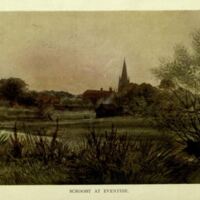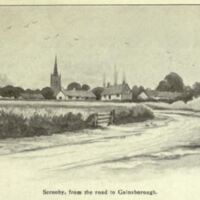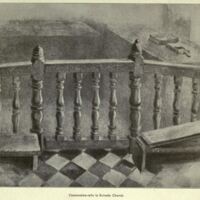Description
The description of Scrooby, Nottinghamshire, provided by Mackennal paints an appealing picture of rural England. The quotation of the Nottingham village as existing in 'a pleasing land of drowsyhead’ borrows from well-known poet James Thomson (1700 – 1748) whose poetic sequence The Seasons (1726-1730) was an important source of inspiration for the Romantic poets. Scrooby is described as a ‘broad meadowland’ where ‘all is leisurely’. Charles Whymper’s illustrations complete the scene focusing on the local church ‘with quiet tower and a short spire, not too obtrusively piercing the sky’:
"SCROOBY, in Nottinghamshire, Scrooby Manor, as it is not very accurately styled in the Pilgrim Story, and in many contemporary documents; Scrooby Court, as, occasionally, the local people call it, has been rediscovered within living memory. It is worth a visit by those who love 'a pleasing land of drowsyhead,' if it were for nothing else than the sense it gives of Tudor England. It lies on the Great Northern Railway, between Retford and Doncaster, on the direct road to Scotland ; and when you have got out at the station, when the smoke of the engine has cleared into the sky and the rattle of the train is borne away, this is what you see. A broad meadowland, not well cultivated, hummocky plots of stiff soil, in which the dock grows plentifully, and through which creeps the River Idle, between low sedgy banks, where rises the yellow flag, a Madonna among the irises, and the marsh marigold spreads, more golden than the buttercups of the field. A grey church is before you, with quiet tower and a short spire, not too obtrusively piercing the sky. And then you come on the little village, consisting of a single street, with three or four rough sideways, leading by scattered cottages to farm-steadings. A solitary horse is drawing a clay-stained cart; cattle browse in stillness, men and women work here, and children go to school; but all is leisurely. Without hurry you recall the memories which have brought you from the town."
This is a deliberately literary passage. The ‘pleasing land of drowsyhead’ makes specific reference to Thompson’s 1748 poem The Castle of Indolence about a perfect summer land of make-believe:
A pleasing land of drowsy-hed it was,
Of dreams that wave before the half-shut eye;
And of gay castles in the clouds that pass,
Forever flushing round a summer-sky.
Such literary allusions are commonplace in works of British history on the Mayflower. James Rendel Harris’s The Finding of the Mayflower (1920) offers frequent literally references to Shakespeare, Milton, and Wordsworth. Likewise, the idealised English landscape is a common motif in Mayflower literature and artwork. This helps add to the pathos of the story: the quiet world of rural England is lost as the persecuted Pilgrims must undertake a perilous voyage across the Atlantic and exchange the safely of home for an uncertain future.




